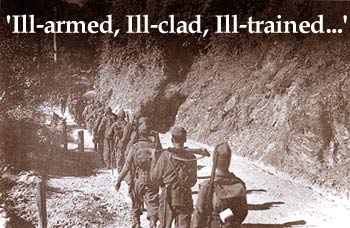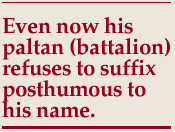The Rediff Special/Brigadier (retd) Chitranjan Sawant, VSM

 In the summer of 1996, more than 35 years after the 1962 war with China, I had an opportunity to stand on the Chinese side of the Dhola ridge and see our own battleground in NEFA [the North East Frontier Agency, now Arunachal Pradesh].
In the summer of 1996, more than 35 years after the 1962 war with China, I had an opportunity to stand on the Chinese side of the Dhola ridge and see our own battleground in NEFA [the North East Frontier Agency, now Arunachal Pradesh].
This was the same Dhola ridge from where the People's Liberation Army of China had attacked the Indian forward positions and rolled down Sela-Bomdilla till the foothills near Tezpur on October 20, 1962.
I was visiting Lhasa, the capital of Tibet, as an independent producer of TV documentaries on Tibet. Having seen NEFA from the Indian side, I asked my hosts if I could have a view of the area from the Chinese side.
There was stunned silence in the banquet hall where the Chinese and Tibetan administrators had hosted a dinner for me. Finally, the Tibetan head of administration, on a cue from his Chinese adviser, said: "Brigadier, you may see, but not shoot." I accepted his suggestion, and next morning Chinese army Mitsubishi Pajeros took me and the crew to the area.
Tough terrain indeed. But not tougher than the one on our side, was my silent verdict after a mental comparison. The altitude was high without causing respiratory complications because of thick foliage. And exactly like on our side, local cowherds tended to their flock unawed by our presence.
The Chinese military intelligence officer (so I presumed) who doubled as a liaison officer appreciated my desire to take a close look at the imaginary international border and touch the Indian soil with reverence. "Sying-sying," he said in Chinese mandarin, indicating his okay, and I lost no time in taking a military look at the massive Dhola ridge from where officers and men of the People's Liberation Army descended on the Indian territory using ropes, bypassing our formidable infantry positions and attacking the nerve centre, headquarters of the 7 Infantry Brigade.
 The brigade commander, Brig John Dalvi, was literally caught with his pants down. The PLA had taken its first VIP red-tab prisoner of war.
The brigade commander, Brig John Dalvi, was literally caught with his pants down. The PLA had taken its first VIP red-tab prisoner of war.
Many more other ranks (junior commissioned officers and jawans) were to fall into their net later. It was indeed a disgraceful show and serving subalterns and captains like me felt let down by those who mattered in the military and civilian set-up.
On the ground hallowed by selfless sacrifice made beyond the call of duty by many of my brothers-in-arms, I stood in silence for more than the customary two minutes. Many images flashed across my mind as I recalled the dramatis personae, both the living and the dead. They seemed to communicate moments of agony and ecstasy depending on courage or cowardice. There were examples galore of both.
Sipahi (later Naik and in present folklore Captain) Jaswant Singh of the 4th battalion of the Garhwal Rifles manned a post with his light machine-gun on a road bend near Sela top. In that bitter snowfall, when the Chinese attacked his post, wave after wave, he stood his ground with grit and determination. His fellow soldiers fell fighting. Outgunned and outnumbered, he still kept the enemy at bay until he finally succumbed to his injuries.
His body was never found, but his memory remains fresh in folklore. Every evening, successive units at the post prepare a bed for him and food is served for his soul, and the local hill population describe him as 'Captain sahib'. I am told that even now his paltan (battalion) refuses to suffix 'the late' to his name.
Then there was Captain (now a retired colonel) S N Tandon, who won a Vir Chakra for gallantry. He and I were gentlemen cadets in the Naushera company of the Indian Military Academy in 1959. He confided in me in the late 1960s that when the soldiers of the PLA captured him as well as his commanding officer, the latter started crying, moaning that he would never be able to meet his wife and children in this life. Tandon being a bachelor had no such emotional outburst.
 The Chinese commissars, Tandon told me later, devoted a lot of time and energy to brainwashing Indian officers and men in the PoW camps. But this did not cut much ice because of family loyalties, and most of them remained steadfast and committed to the Indian values of life.
The Chinese commissars, Tandon told me later, devoted a lot of time and energy to brainwashing Indian officers and men in the PoW camps. But this did not cut much ice because of family loyalties, and most of them remained steadfast and committed to the Indian values of life.
My reverie was broken by my film crew, who pointed out that it was getting late and time to return to base.
Where did you face us in 1962, asked Mr Qiao, one of the Chinese officials, in a light-hearted manner. "Here, there, and everywhere," I replied, and we all laughed it away.
Tomorrow would be another day, I said to myself, and tried to sleep.
But sleep eluded me that night. The 1962 debacle of our army kept haunting me. Jawaharlal Nehru's words that China had stabbed India in the back by launching a dastardly attack crisscrossed my mind many a time. Now, four decades after the bitter war, I was their guest.
The Chinese always kept emphasizing that they were not the aggressors. Chou En-lai, the then Chinese prime minister, and other Chinese decision-makers had taken Nehru's off-the-cuff statement made in Madras on October 12, 1962, that he had "ordered the Indian Army to throw the Chinese out" very seriously.
The PLA in Tibet, where they were entrenched since 1950, mobilized to launch a pre-emptive attack on NEFA.
In an academic discussion with my Chinese hosts, I asked them: "Didn't you fire the first shot?" The Chinese hosts replied that after Nehru's provocative statement amounting to a declaration of war, a self-respecting nation like China could not have waited to be attacked.
I recall that the Americans were very sympathetic to the Indian Army's debacle in NEFA and were convinced that China was the aggressor. If memory serves me right, the Americans used the term 'Himalayan Pearl Harbour' to describe our discomfiture as akin to their own.
The other view was that we Indians got what we had asked for. The author of India's China war, Neville Maxwell, exonerated the Chinese and said blaming them was 'a soothing fantasy' for the Indians.
When I look back over these 40 years of my own experience in the Indian Army as a student of military history, I feel that the last word on the subject has not been said. Perhaps a latter-day historian with an unbiased mind and access to declassified war diaries may arrive at this image-shattering deduction: the unpronounced rivalry between Nehru and Chou En-lai to play a dominant role in Asia was the root cause of the military conflict in 1962.
Of course, undefined and undemarcated borders in the high Himalayas were a British legacy that the independent Indian government carried forward. The British imperial military power could sustain the theory of undefined borders and make inroads into Tibet. But independent India, without the backing of a mighty military machine, found the vagueness of borders a heavy burden, which was difficult to carry and not easy to shake off.
The Chinese were gaining strength day by day after October 1, 1949, when New China was born. Consequently, when the PLA moved into almost independent Tibet in 1950, the Indian foreign policy makers did not even whimper, let alone think of an intervention. The remnants of the Indian mission and post office in Lhasa were wound up post-haste.
The Indian Tri-colour was never to flutter in the Lhasa breeze again.
 Reverting to the military operations in NEFA, we find that the 4th Indian military division degenerated into a complete rout without giving a sustained battle to the intruding Chinese. When the PLA launched its first wave of attacks on October 20, 1962, some Indian Army units in Walong on the far eastern side did offer determined resistance. But on the Dhola-Sela-Bomdilla axis it was a complete rout.
Reverting to the military operations in NEFA, we find that the 4th Indian military division degenerated into a complete rout without giving a sustained battle to the intruding Chinese. When the PLA launched its first wave of attacks on October 20, 1962, some Indian Army units in Walong on the far eastern side did offer determined resistance. But on the Dhola-Sela-Bomdilla axis it was a complete rout.
In all fairness to the Chinese, it must be mentioned that they had offered a ceasefire and a negotiated withdrawal from Indian territory when they met stiff resistance in the Walong sector. But the Indian Army and political leadership --- wishing "to throw the Chinese out" --- found that a humiliating proposition. But throwing the Chinese out remained wishful thinking.
On November 15, 1962, some Indian Army units launched a counter attack and gained limited success. There was a short thaw in the battle. Then the PLA inducted more men and new guns to renew a determined onslaught, which totally routed the Indian side. The magnitude of their attack had to be seen to be believed.
Rumours in the Indian rank and file aided the Chinese more than their own military tactics. A mere whisper of Chinese soldiers being seen in the vicinity would send rank and file running for cover where none was available. To our eternal shame, the commanding general and his colonels, leave alone the jawans, deserted their posts and gave the Chinese army a free run up to the foothills near the town of Tezpur. Disabled jawans who had lost their limbs in snow and literally walked into Chinese PoW camps cursed themselves and their officers for the sad state.
But military strategists all over the world appreciated that the Indian jawans even while retreating from battle, never abandoned their rifles. An unprepared army, ill-armed, ill-clad, and ill-trained for mountain warfare, had been ordered to give battle to seasoned PLA officers and men who had more than a decade's experience of mountain warfare in Tibet.
 The majority of the Indian soldiers did not have suitable winter clothing and proper footwear for snowbound battlefields. Ammunition was in short supply because quite a few ponies carried commodes for officers instead of ammunition for soldiers. The command and control from corps headquarters downwards was non-functional.
The majority of the Indian soldiers did not have suitable winter clothing and proper footwear for snowbound battlefields. Ammunition was in short supply because quite a few ponies carried commodes for officers instead of ammunition for soldiers. The command and control from corps headquarters downwards was non-functional.
Lieutenant General B M Kaul, commanding general of the newly raised 4 Corps at Tezpur, had never commanded an active fighting outfit notwithstanding his Sandhurst training. Instead of planning military strategy at Tezpur or in forward areas, he wasted crucial days in Delhi nursing a sore throat.
While the military situation of the Indian Army was in such a mess, the Chinese once again caught us by surprise by declaring a unilateral ceasefire as they had no visible Indian units to fight. In one stroke they scored a military-cum-diplomatic victory.
I shall be failing in my duty, however, if I do not pay tribute to the gallantry of those who fought till the last round and last breath. Among them stands tall Brigadier Hoshiar Singh, commander of the Sela Brigade, who gave a bloody nose to the Chinese even after being cut off from his division headquarters at Bomdilla. He made the supreme sacrifice in action.
Subedar Joginder Singh too went beyond the call of duty, inflicting heavy casualties on the enemy and saving the lives of his men. The nation honoured him with the Param Vir Chakra, the country's highest gallantry award in war, posthumously.
They who died for the country still live in their countrymen's memory. We salute our martyrs, cherish their memories, and encourage our young ones to emulate them.
Brigadier (retd) Chitranjan Sawant is a Sinologist and a qualified interpreter of Mandarin. He was deputed by the Government of India to study the Chinese language and affairs in California after the 1962 Sino-Indian war, when he was posted in the Ladakh sector. He has visited China and Tibet thrice and produced television documentaries.
